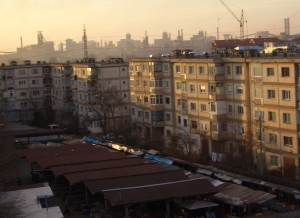Perhaps the most enduring symbol of the Soviet experiment is their architecture. During the spring of 2007, I lived in an oft-forgotten corner of Romania, working to expand HOPE’s work into the country. As with all former Soviet republics, Romania’s cities are filled with massive apartment blocks, exemplified in this picture which was taken from the window of the apartment where I lived.

They aren’t pretty. These concrete, gray monstrosities line every street, each one in a different state of disrepair. Not only do they blight these communities, but it also made navigating Romanian cities a nightmare (try finding your apartment when all the buildings are carbon-copies of one another).
The shared common space of the buildings was disastrous. The façade, lobbies, and stairwells –the commons–were always in terrible condition. The interesting thing about these buildings was that once you reached the door of the apartments, the “home” began. Inside, many of the apartments were actually quite nice, though you’d never know it from the outside.
The Communist regime built these concrete palaces but did a poor job (read: terrible) of maintaining them. Individuals buy the apartments within the building, but not the building itself. As a result, nobody maintains the lobbies, the landscaping or the exterior walls. Individual apartment owners simply fend for themselves, meaning the majority of urban Romanians live in ugly housing. The Romanian government proved time-and-again that it was a terrible landlord.
Under Communist systems, the government serves owns the real estate. The tragedy of the commons is just one of a litany of Communism’s fatal flaws. We see glimpses of this economics reality every day in simple things like the way we drive rental cars (versus our own cars) and in the condition of dormitory bathrooms. Successful economic systems take the tragedy of the commons seriously, acknowledging that when “everyone owns it, nobody does.”

Romanian Apartment Block
They aren’t pretty. These concrete, gray monstrosities line every street, each one in a different state of disrepair. Not only do they blight these communities, but it also made navigating Romanian cities a nightmare (try finding your apartment when all the buildings are carbon-copies of one another).
The shared common space of the buildings was disastrous. The façade, lobbies, and stairwells –the commons–were always in terrible condition. The interesting thing about these buildings was that once you reached the door of the apartments, the “home” began. Inside, many of the apartments were actually quite nice, though you’d never know it from the outside.
The Communist regime built these concrete palaces but did a poor job (read: terrible) of maintaining them. Individuals buy the apartments within the building, but not the building itself. As a result, nobody maintains the lobbies, the landscaping or the exterior walls. Individual apartment owners simply fend for themselves, meaning the majority of urban Romanians live in ugly housing. The Romanian government proved time-and-again that it was a terrible landlord.
Under Communist systems, the government serves owns the real estate. The tragedy of the commons is just one of a litany of Communism’s fatal flaws. We see glimpses of this economics reality every day in simple things like the way we drive rental cars (versus our own cars) and in the condition of dormitory bathrooms. Successful economic systems take the tragedy of the commons seriously, acknowledging that when “everyone owns it, nobody does.”

Trackbacks/Pingbacks